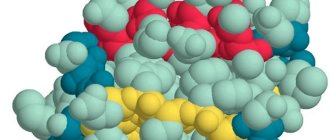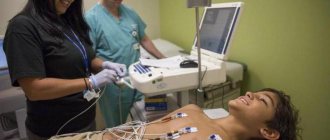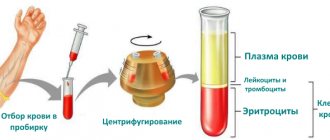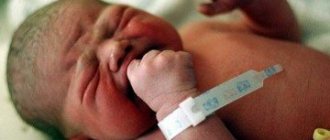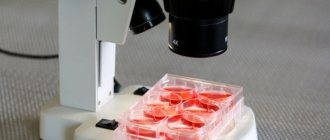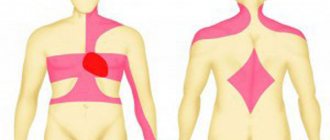0
Author of the article: Marina Dmitrievna
2017.08.10
496
Red blood cells
Blood tests often reveal abnormalities. In some cases, studies show a decrease in the number of red blood cells. This may be due to physiological reasons or various diseases. In these cases, parents should show concern and find out what is the reason for such indicators.
Erythropenia in a child
Formed elements of blood - red blood cells
Experts say that the indicator of the number of red blood cells as a result of a child’s blood test is one of the most important. If the level of these cells decreases, they speak of erythropenia in the baby. Moreover, the reasons are varied - both physiological and pathological when a child develops a disease.
Red blood cells are the most abundant cells in the blood. They are responsible for transporting oxygen to tissues and various organs, thereby ensuring the respiration of even the smallest cells of the body. Essentially, these are biconvex disks invisible to the eye, without a nucleus, but filled with hemoglobin.
Red blood cells live in the blood from 90 to 120 days, after which the process of their destruction and replacement with others begins. This process is called hemolysis and it occurs in the spleen; the liver can also be involved in this action. If the process goes wrong and recovery is slow, there is a decrease in blood cell levels. And here you should understand when to panic and when not.
The role and functions of red blood cells in children's blood
A normal red blood cell has the shape of a small biconcave disk with a diameter of 7 - 9 microns and a thickness of 2 - 2.5 microns. The red color of blood is caused precisely by red blood cells containing large amounts of hemoglobin.
The most important function of red blood cells is to transport oxygen from the lungs to organs and tissues, as well as carbon dioxide in the opposite direction.
In addition to the function of gas exchange, red blood cells:
- transport amino acids (these are protein components) from the gastrointestinal tract to cells;
- bind toxins and antigens, protecting the body from their effects;
- perform an enzymatic function, carrying specific proteins - catalysts;
- maintain acid-base balance.
One small cell would not be able to cope with this important task, but due to the fact that there are so many of them, gases, enzymes, and amino acids regularly move throughout the body.
Norms by age
Children of different ages have their own specific norms of red blood cells
Doctors determined normal indicators of the presence of red blood cells in the blood, which ensure the proper functioning of the body. And, based on these values, they determine whether there is an increase or decrease in the level. Normal indicators look like this:
| Child's age | Blood counts (1 million per mm3) |
| Blood from the umbilical cord | 3,9-5,5 |
| 1-3 days | 4-7,2 |
| 4-7 days | 4-6,6 |
| 2-4 weeks | 3,6-6,2 |
| 1 month | 3-5,4 |
| 2 months | 2,7-4,9 |
| 3-11 months | 3,1-4,5 |
| 1-2 years | 3,6-4,9 |
| 3-12 years | 3,5-4,7 |
| 13-19 years old | 3,5-5,6 |
Red blood cells are measured as one million cells per 1 mm3 or as 1012 per 1 liter of blood fluid. Normal corpuscle indicators directly depend on age norms, but have no connection to the gender of the child, i.e. for children of different sexes they will be the same.
Deviations from the norm
An indicator of deviation from the norm of red blood cells in a child’s blood is the number of red blood cells. Changes in indicators in children are: natural (heavy fluid intake, bleeding, menstruation, staying in the mountains, diarrhea) and pathological. An increase or decrease in the number of blood cells signals the presence of diseases that impair the supply of oxygen to tissues and organs.
Erythrocytosis
Polycythemia is a rare disease that occurs when there are too many red cells circulating in the blood. Red blood cells in a child's blood carry oxygen from the lungs to all parts of the body and organs. Excess red blood cells cause the blood to swell and thicken, preventing it from flowing easily.
Important information: What do low leukocytes mean in a blood test in women (reasons for low levels)
Polycythemia is divided into 2 overarching categories:
- A primary pathology caused by an overproduction of cells in the bone marrow due to a mutation or biological factor in the body.
- Secondary polycythemia is caused by factors that reduce the amount of oxygen reaching the body's tissues, such as maternal smoking during pregnancy, high altitude, or congenital heart disease. Red blood cells in children with the secondary form of the disease produce an abnormal form of hemoglobin that does not readily release oxygen (high-affinity hemoglobin hb).
There are 3 forms of primary polycythemia:
- True form or primary polycythemia of bone marrow, hematopoietic stem cells. The disease affects children over 16 years of age.
- Familial or congenital polycythemia, caused by genetic abnormalities or inappropriate levels of the hormone erythropoietin.
- Newborn pathology detected at birth is treated in the neonatal intensive care unit.
The kidneys produce excess of the hormone erythropoietin in the absence of oxygen. This stimulates the red bone marrow to produce new red blood cells.
Erythropenia
To produce normal red cells, the body maintains a sufficient supply of erythropoietin (EPO). Missing red blood cells in a child’s blood reduces hemoglobin, and anemia develops. The disease may be caused by cancer or disorders or infections that damage the bone marrow. Hormone replacement, antifungal medications and other diseases that cause anemia aggravate the course of erythropenia.
Diagnosis of pathology in children and adults is based on laboratory analysis. If a mild stage of the disease is detected, treatment of the child is not required. Moderate and severe forms of erythropenia require (immediately after identifying this condition) the use of specific medications and supplements. Nutrition correction and the introduction of foods high in Fe to children under 1 year of age should be carried out under the supervision of a therapist or local nurse.
Types of erythropenia
Drinking too much can cause relative erythropenia
A decrease in the level of red blood cells in a child’s blood is divided into two types:
- Relative
- Absolute
In the first case, they talk about a false decrease in the number of cells, because their total number remains at a normal level, but the overall indicator drops against the background of some blood thinning. This happens if a child drinks a lot.
Absolute pathology is caused by a lack of cells in the blood, which appears against the background of their insufficient formation or faster destruction.
Red blood cells below normal (causes, symptoms)
A decrease in the level of red blood cells in the blood is called erythropenia and can be caused by the following reasons.
- Inhibition of red blood cell production in the bone marrow.
- Increased destruction of them in the bloodstream.
- Increased excretion from the body.
A decrease in output may be due to:
- deficiency of vitamins and microelements (insufficient intake from food - diets, low social level and poor nutrition, vegetarianism);
- the presence of bone marrow tumors (benign and malignant);
- poisoning by poisons, medicinal substances, chemical compounds (low-quality materials from which toys, furniture, etc. are made);
- exposure to radiation.
Increased destruction in the bloodstream may occur as a result of:
- autoimmune reactions (the most familiar example is Rh conflict);
- exposure to pharmacological drugs;
- prolonged inflammatory processes;
- infectious lesions;
- low osmotic resistance of the red blood cells themselves.
- Increased loss of red blood cells occurs when:
- bleeding due to injuries, surgical interventions;
- in case of renal pathologies, when red blood cells are released into the urine (normally there is a renal barrier);
- for pathologies of the gastrointestinal tract that provoke internal bleeding and the release of red blood cells in the feces.
Erythropenia has no characteristic and clearly defined symptoms. Children may experience:
- lethargy, drowsiness, weakness, fatigue, retardation of movements;
- desire to eat chalk, lime, sand and other inedible things;
- decreased or loss of appetite;
- rapid heartbeat even at rest;
- skin pale, moist, cool;
- tinnitus, decreased vision;
- dizziness and loss of consciousness;
- frequent respiratory viral diseases.
A decrease in the number of red blood cells leads to impaired gas exchange - a lack of oxygen and difficulty removing carbon dioxide. This has a negative effect on the growing body and can cause developmental delays and various diseases.
Causes
Helminthiasis can cause erythropenia
Naturally, many are interested in the reasons why this situation may arise. A decrease in the level of such blood cells occurs against the background of:
- Failures in the appearance and creation of red cells in the bone marrow area: here the catalysts are vitamin deficiency and lack of minerals, for example, when eating like vegetarians, as well as poisoning of the bone marrow by various poisons, tumor formations, radioactive radiation, drugs, etc.
- Destruction of red blood cells directly in the bloodstream: this happens against the background of various inflammations, infectious manifestations in the body, the presence of parasites, autoimmune reactions, poisoning and other negative effects on blood cells
- Excessively active release of cells and their destruction: this can develop against the background of bleeding, for example, during an injury or during surgery, problems in the functioning of the kidneys or intestines
Infectious diseases lead to a decrease in red blood cells
As a rule, a decrease in such an important blood indicator is determined against the background of diagnosed pathologies from the following list:
- manifestations of anemia, i.e. oxygen transport failures;
- pathologies caused by hereditary nature;
- leukemia;
- a disease called hemolytic;
- neoplasms of a malignant nature;
- manifestations of hemophilia;
- diphtheria, whooping cough manifestations and other infectious pathologies;
- hepatic cirrhosis;
- lack of work why chronic course;
- ulcers in the gastrointestinal tract.
This list indicates that the situation when the level of such cells decreases is very dangerous, often fatal, for the body.
Symptoms and signs
Decreased or lack of appetite is a wake-up call
It is important to know what signs indicate a problem. This will allow you to take action in time. So, among the main symptoms of erythropenia in a child are:
- pallor of the skin, lips and even mucous membranes;
- increased fragility of the nail plates, and hair also becomes more brittle;
- loss of appetite;
- the appearance of unusual and even wild, in the eyes of many, eating habits - the desire to try chalk, clay, chew paper;
- increased fatigue;
- psychological depression;
- problems with physical development - often referred to as retardation.
If erythropenia is not pronounced and is at the initial stage of its development, the child may experience symptoms such as dizziness, tinnitus, headaches, and visual disturbances may also occur, in which the appearance of spots in the eyes or white spots can be noted.
Why is erythropenia dangerous for a child?
Erythropenia leads to decreased immunity
Of course, the question: why is this situation dangerous for the baby worries many parents who are faced with such a diagnosis. It is important to understand here that a decrease in the level of red blood cells leads, first of all, to an insufficient supply of oxygen to the body tissues. And he is the basis of life. In addition, at the same time, the removal of carbon dioxide from cells deteriorates. Against this background, the functioning of the body begins to deteriorate, and disruptions occur in the functioning of internal organs. In childhood, this is especially dangerous and leads to developmental delays.
And against this background, the child’s body’s defenses begin to deteriorate and immunity drops. There are also problems with blood clotting.
Diagnostics
High or low levels of red blood cells are detected during a complete blood count. This laboratory test may require either capillary or venous blood.
Parents should ensure that the child is hungry before taking blood, since the most reliable results will be obtained only when the biological material is taken on an empty stomach. If this is not done, a repeat analysis will be required, which is extremely undesirable for children, especially younger ones.
The results are interpreted by a hematologist, who pays attention not only to the number of red blood cells, but also to their sedimentation, or rather the speed at which this occurs. After this, the doctor transmits the information received to the pediatrician - this specialist draws up a further individual diagnostic program for each patient. This is necessary to find the root cause.
Diagnostic measures common to all are:
- a clinician's examination of the medical history to look for an acute or chronic underlying disease;
- familiarization with family history - to establish the influence of genetic predisposition;
- collection and analysis of life history - to confirm or refute the influence of harmless causes;
- a thorough physical examination and assessment of the condition of the skin;
- a detailed survey of the patient’s parents - to determine the first time of occurrence of characteristic signs and compile a complete symptomatic picture.
Additional diagnostic tools include:
- specific laboratory tests;
- instrumental procedures;
- consultations with pediatric specialists from other areas of medicine.
What to do
Consultation with a pediatrician should be the first step in resolving the issue.
Treatment of such a problem should begin with a deeper and more detailed diagnosis. It is necessary to accurately determine the cause of the failure. Most often, doctors note, pathology manifests itself against the background of anemia. And here correction of the situation with the help of iron-containing drugs will help. In addition, the list of prescriptions may include B vitamins and folic acid.
If the problem lies in the activity of the bone marrow, medications may be offered that regulate its activity and stimulate the production of blood cells.
If the problem is caused by blood loss, it is often necessary to resort to surgery and blood transfusions.
